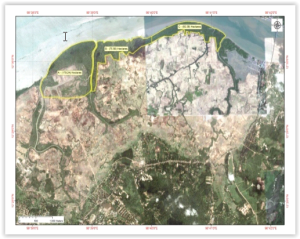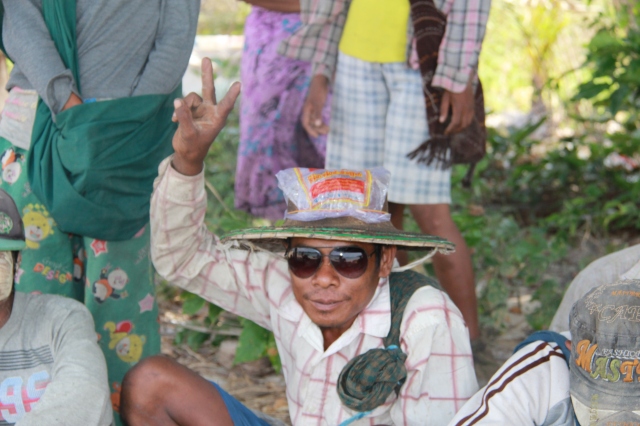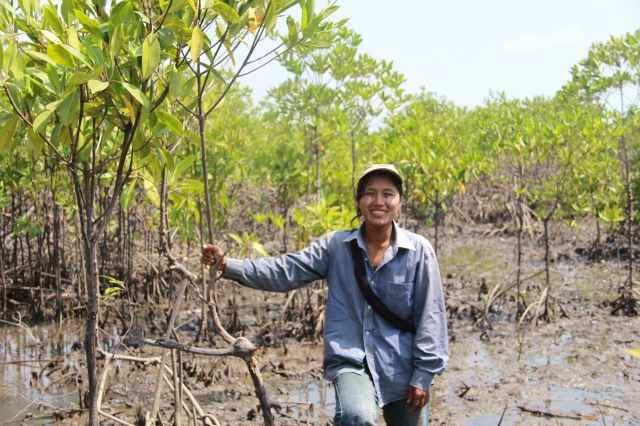 Human Capital Development through Natural Capital Restoration:
Human Capital Development through Natural Capital Restoration:
Participation of people is vital in restoration mangrove forests. Worldview has during the last two years established several nurseries by engaging small scale farmers in local restoration projects, supported by students on research grants and monitored by professors in charge and the project’s international director. Community participation is vital. The poorest of the poor will use any opportunity to generate income, and will only be able to fully participate as custodians of this future life saving process if there is an immediate economic benefit for their daily survival.
From the start, the Worldview research project has tested new livelihood activities as an alternative to mangrove destruction for survival. So far there are positive results from nypa sap harvest, soft shell crab nurseries, bee honey production and orchid growing in mangrove forests. These activities including development of sustainable mangrove management practices for income opportunities (harvest techniques and practices not harmful to the health of the forest) as a demonstration and training projects for local communities with people’s participation. The parks will function as resource centres in scientific research and as a catalyst for sustainable livelihood for the poor. Mobilizing small farmers and especially women to establish mangrove nurseries for park development will add valuable income to local communities. A case in point is Kan Su village with 42 plant growers, most of them women. Employing villagers for planting and working in the park provides economic benefit for local communities as well as creating fruitful partnership for successful implementation.
Thus far we have observed that whether it is charcoal production, or raising mangrove seedlings, women are key partners and income generators for their families. In Myanmar, women are also afforded a voice in community discussions. We believe that direct investments in the climate park concept is a significant indirect investment in the empowerment of women, with well known multiplier effects.
Indeed, in the nypa and orchid projects, most of the involved beneficiaries are women and in fact we have been told by local women how much they would value the inclusion of day care centers in the projects. Such day care centers would become significant social development tools in themselves, of course, providing local children health and educational benefits.
Currently, village women not only take care of their children and families, but they also work daily in rice harvest and other traditional forms of work. Their days are full to say the least, leaving little time for learning new skills or entrepreneurial involvement. But if women could entrust their children to a nearby locally run day care center, they could be free to pursue higher value income generating projects such as the spin-offs of mangrove restoration. (It is also noteworthy that at Pathein University, almost all department heads are women, and all are eager to contribute to the inter-disiplinary research and activities inherent in the climate park projects.)
ASEAN MODEL:
It is worth noting that Myanmar is the poorest country in the ASEAN region. The country deserves support in its efforts towards democracy and sustainable development. The proposed Mangrove Parks could be a flagship projects during Myanmar’s ASEAN Chairmanship in 2014, with a wide demonstration effect to be shared with other ASEAN countries and beyond (ref. attached letter from Director General ASEAN).
Establishment of the Climate park as the first step in national restoration of mangroves with the following impact:
- Reverse devastating effects of Myanmar’s destructed natural mangrove forests.
- Protect coastal areas from the worst effects of cyclones and other adverse weather patterns, including tsunamis, with potential to save thousands of lives and properties
- Provide up to 50% more sea food with better and secured breeding environments
- Mitigate up to five times more CO2 than rainforest trees and reduce escalations of global warming
- Generate cooling effect from planted trees with 60,000 BTU per tree
- Create livelihood opportunities to disadvantaged coastal communities by reducing
- Save lives and improve quality of the environment for millions of people in adaptation to climate change
- Contribute to social and economic development of a peace building process in a new democracy.
 Mangroves also contribute substantially to cooling of the environment. This is a valuable attraction at a time of global warming. Average cooling effect from photosynthesis is estimated at up to 120,000 BTU per plant of Soneratia, Rhizophora and Bugeria species, equivalent to 10 room sized air-condition units in 20 hours operation (total 144 billion BTU).
Mangroves also contribute substantially to cooling of the environment. This is a valuable attraction at a time of global warming. Average cooling effect from photosynthesis is estimated at up to 120,000 BTU per plant of Soneratia, Rhizophora and Bugeria species, equivalent to 10 room sized air-condition units in 20 hours operation (total 144 billion BTU).
At a time with growing concerns for acidity in the oceans due to CO2 emissions, it is also worth noting that this miracle tree also have capacity to clean polluted water.
 In sum, in Myanmar, mangroves, orchids, new livelihoods – the nation itself – is ready to bloom. This project is an essential component of “green economic growth” at a relevant scale and we believe it will prove vital and essential to the overall future of Myanmar.
In sum, in Myanmar, mangroves, orchids, new livelihoods – the nation itself – is ready to bloom. This project is an essential component of “green economic growth” at a relevant scale and we believe it will prove vital and essential to the overall future of Myanmar.








